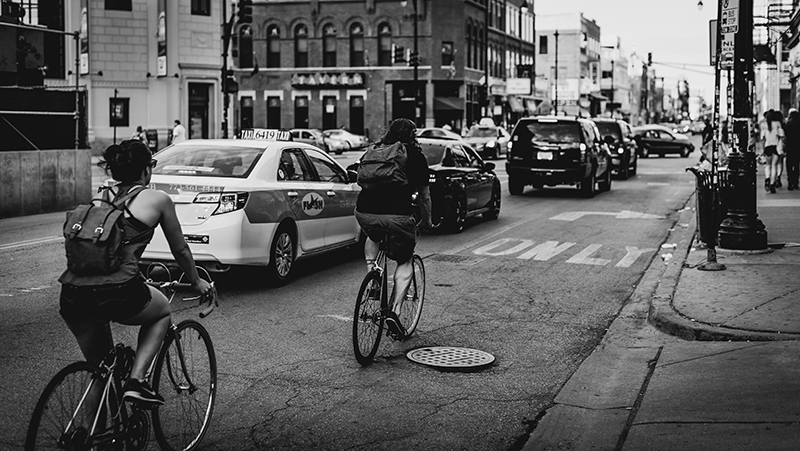 Photo by Adrian Williams on Unsplash
Photo by Adrian Williams on UnsplashA right hook is one of the most common, and most feared, types of crashes known to cyclists. Victims are often left with broken collarbones, concussions, road rash, and damage to their bikes. More serious collisions can involve traumatic brain injuries, fractured ribs, spinal cord damage, and even death. The only good thing about a right hook (there's actually nothing good about a right hook) is the cyclist's ability to see it coming, in some cases. As such, there are defensive riding tactics that you can employ to avoid a driver's right hook that we'll discuss below.
What is a Driver's Right Hook?
First of all, what is a right hook? It's simply a term used to describe the type of crash a driver causes when they make a right turn into a cyclist who is going straight in the bike lane or going straight on the shoulder of the road. Right hooks happen when the driver fails to yield right of way by 1) not checking their mirrors before they turn, 2) not checking their "blind spot" by looking over their shoulder before they turn, or 3) seeing the cyclist and deciding to turn anyways. Some drivers believe they have the right of way in this scenario. They are wrong. Colorado law is on the side of the cyclist. According to the "Bike Lane Bill" signed into law in 2020, drivers must "yield the right of way to a bicyclist ... in a bicycle lane." Failure to yield right of way is a Class A Traffic infraction even if the cyclist is not hit or injured. However, cyclists also have the right of way in this scenario even if the road does not have a bike lane.
Five Methods You Can Use to Avoid The Right Hook
- The first step is to simply survey the driver and their vehicle, and determine what the chances are of them making an abrupt right hand turn into your path.
- Check the driver's turn signals. If they have their right blinker on, chances are they are going to turn.
- If possible, look inside the vehicle at the driver. Are they looking down at their phone? Do they seem otherwise distracted? Are they checking their mirrors as if they might be thinking of turning? Are they slowing down, as if to make a right turn? As we all know, not all drivers use their turn signals. If a driver's windows are not heavily tinted, sometimes you can make a quick guess about their direction by taking a quick glance at them from behind or when you're riding parallel with them.
- If you aren't sure what the driver plans on doing, it is best to simply assume they will turn.
- Get the driver's attention! If you have the ability to speed up and ride past the vehicle so that you can pull up in front of them (not parallel), you will no longer be in any type of blind spot and the driver will be much more likely to see you. Better yet, if you can simply pass the vehicle altogether before the vehicle reaches the turn, you are in the clear. However, this does carry some risks, as drivers are known to begin merging into the bike lane before they reach the turn. Speeding up like this also poses the risk that you may not end up having enough speed to beat the driver to the turn.
- If in doubt, back off and let the driver cut you off from a safe distance. While frustrating, this is sometimes (though not always) the safest option. It may not be the safest option during heavy traffic or if there are other vehicles behind the vehicle in question that may also be turning. If you back off too much, the other drivers behind the one you were originally worried about may think to themselves that they too can get around you without having to wait. To ride safely in traffic, you need to be assertive when it makes sense.
- The least convenient option, but the safest, is to slow down, put a foot on the curb, and wait for the danger to pass. During heavy traffic, or if you are experiencing PTSD from a previous crash, there is no harm in doing this.
- Slam on your brakes, or turn with the vehicle. In some emergency situations, there is no time to react other than to slam on your brakes. If you have a split second longer, it may be beneficial to brake and/or turn with the vehicle. You may glance off the side of their car, but in some cases it is possible to stay upright if you begin the turn early enough.
A Note About Trucks and Right Hooks
Semi-trucks, buses, and vehicles towing large trailers may start their turn from the left lane of a four-lane road, or from the center lane of a three-lane road. Beware of these larger turning vehicles, as they may abruptly begin a right turn from a lane that a passenger vehicle would not normally use.
Reach Out to Colorado Bike Law
When it comes to defensive riding tactics, there is no single method that works in every situation. It may be safest to back off and let the car turn in front of you from a distance, even though you have the right of way. In another scenario, you might only have a chance at slamming the brakes on to avoid being hit. Sometimes, avoiding a right hook is simply not in your control. If you were injured in a right hook crash, another type of bike vs. car collision, or have questions about defensive riding tactics, do not hesitate to reach out to Colorado Bike Law today.
